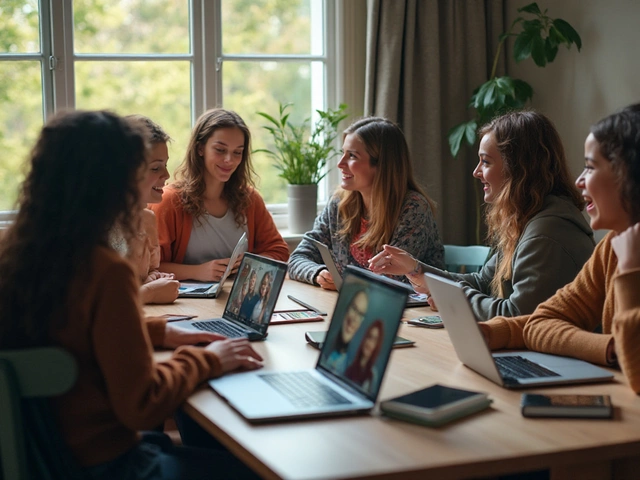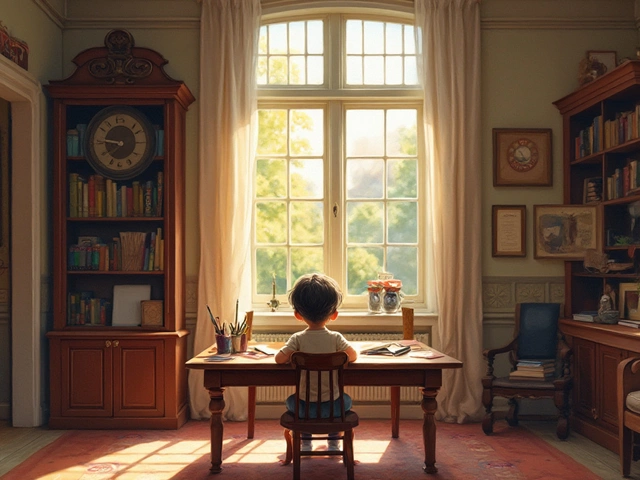Most people picture learning disabilities as something only kids deal with in school. But what if you’re an adult, or if you start noticing new struggles as you age? The biggest question is—can learning disabilities actually get worse over the years?
If you’ve ever felt your memory slipping, found it harder to focus, or run into new challenges at work or in daily life, you’re not alone. It's easy to worry that your learning disability is ramping up. But here's the straightforward truth: a learning disability itself doesn’t “grow” or “spread” with age, like a broken phone screen getting bigger. It’s not an illness or injury—it’s a way your brain processes information.
But that doesn’t mean things always stay exactly the same. Life changes. New demands, stress, or even health issues can make old challenges stand out, or new ones pop up. The good news? You can take control. Simple changes in how you approach tasks, how you organize your day, or even how you ask for help, can make a massive difference—at any age.
- What Are Learning Disabilities, Really?
- Do Learning Disabilities Change as You Get Older?
- Common Myths vs. Real Stories
- What Makes Things Better—or Worse?
- Tips to Manage at Any Age
- Finding Help That Actually Works
What Are Learning Disabilities, Really?
Learning disabilities are not about how smart someone is. They’re about how the brain works with reading, writing, math, and other skills. So if you find written instructions confusing, or you mix up numbers, this might be why. It’s not lack of effort or intelligence. It’s simply your brain connecting the dots in a different way.
Doctors and educators use the term "learning disabilities" as a broad label for a few different challenges. Here are some of the most common types:
- Dyslexia: Struggles with reading, spelling, or recognizing words.
- Dyscalculia: Trouble with numbers or math concepts.
- Dysgraphia: Difficulty with writing or making your thoughts clear on paper.
- Auditory Processing Disorder: It’s tough to understand sounds or spoken information.
- Nonverbal Learning Disability: Issues with interpreting visual cues or social skills, even if verbal skills are strong.
Check out these quick stats to get a sense of how common learning disabilities are:
| Type | Percentage of U.S. Students |
|---|---|
| Dyslexia | 5-10% |
| Dyscalculia | 3-6% |
| Dysgraphia | 5-20% (overlap with dyslexia) |
According to the National Center for Learning Disabilities, about 1 in 5 children in the U.S. has a learning or attention issue. But even with these numbers, many adults don’t realize they have one, because the signs can be missed or misunderstood. The most important thing? A learning disability sticks around for life, but how much it gets in your way can change, depending on support, tools, and attitude.
Do Learning Disabilities Change as You Get Older?
Here’s a fact many folks don’t realize: actual learning disabilities, like dyslexia or dyscalculia, usually show up in childhood and don’t just appear out of nowhere later in life. That means if you had a hard time with reading, math, or writing as a kid, you’re likely to face those same core struggles as an adult. The challenges might stick around, but they don’t automatically get worse just because you’re getting older.
But there’s a twist. Life demands change all the time. For example, what was tough in elementary school—like reading out loud—might shift as you get older to struggles with writing emails, understanding work instructions, or keeping up with paperwork. The environment changes, but the way your brain works is pretty stable. Sometimes, when school support fades away or adult life gets more complicated, the difficulties can feel bigger even though the disability itself hasn’t technically “worsened.”
Research over the last few decades says the same thing—learning disabilities don’t progress like a degenerative disease. What really changes is how they show up and how you deal with them. If someone goes years without support or tools, they might develop stress, anxiety, or feel burned out. But that’s more about what’s stacked on top of the disability, not the core problem itself.
If you’re facing new challenges that seem sharper than before, it’s smart to ask: are you dealing with added stress, less support, or new health issues (like hearing loss, anxiety, or attention problems)? All of these can make learning hurdles feel harder without the actual learning disability getting any worse.
So, the takeaway—it’s not usually learning disabilities that change as you age, but your world does. And when your world changes, what you need to keep up can shift too. Staying aware of that is half the battle.
Common Myths vs. Real Stories
There are a lot of rumors and wrong ideas floating around about learning disabilities. Some folks believe they fade away with age, while others are sure things just get worse. Let’s clear up the confusion and look at what actually happens.
Learning disabilities don’t magically disappear when you become an adult. A 2023 CDC study showed that about 4.5% of adults in the U.S. live with a diagnosed learning disability. Even so, myths keep popping up. Here are the biggest ones:
- "Learning disabilities are just a childhood problem." Tons of adults still struggle with reading, writing, math, or organization. The way challenges show up might change—like struggling at work instead of school—but they don’t vanish at 18.
- "If you didn’t have obvious issues as a kid, you’re home free." Adult life asks new things from us. Time management, multitasking, or organizing finances can bring learning issues to light, even for folks who flew under the radar in school.
- "Getting older automatically means getting worse." Aging can make it harder to focus or remember things, but that happens to everyone. It’s not proof that a learning disability is suddenly worse. What can change are your coping skills and the support available.
- "You just need to try harder." This one causes way too much guilt. Learning disabilities are about how the brain processes info, not about willpower or effort. Plenty of adults have put in serious work for years, and no amount of grit can rewire the brain.
So, what’s the real story? Real people find ways to deal, often with tools, tech, or habits they’ve built up over time. But if life throws curveballs—like a new job, a medical problem, or even using unfamiliar tech—old struggles can flare up, making it seem like things are “worse.”
Check out this quick look at the facts:
| Belief | Reality |
|---|---|
| Only kids have learning disabilities | About 15% of adults report lifelong struggles with reading, writing, or math |
| Learning disabilities always get worse with age | No direct evidence for this—worsening usually ties to stress, lack of support, or new demands |
| If you can read or write, you don’t have one | Some adults hide difficulties or develop clever workarounds, even in high-level jobs |
Hearing real stories from adults helps paint a fuller picture. Like Olivia, who nailed her career as a chef but still uses text-to-speech apps because reading recipes quickly is tough. Or Mike, an accountant with dyslexia, who says switching to digital tools in his 40s was hard—until he found software that reads numbers out loud. Their challenges are real, but so is their ability to adapt.

What Makes Things Better—or Worse?
Here’s the surprising scoop: learning disabilities usually stay pretty consistent, but how much they mess with your daily life can shift a ton depending on what’s going on around you. Stress, changes at work, new health issues, or even something as simple as trying to do too many things at once can make struggles more obvious. On the flip side, the right support and good habits make a world of difference.
One thing experts agree on? You can absolutely stack the odds in your favor. Dr. Brock Eide, author and learning disabilities advocate, puts it like this:
"When people with learning differences have the right strategies and support, their difficulties don’t define their success."
So what are the main things that can turn the tide, for better or worse?
- Stress: When you’re anxious or overwhelmed, your brain struggles to keep up, and learning difficulties get worse.
- Life transitions: Switching schools, jobs, or even moving houses can shake up routines and make things feel tougher.
- Health changes: Sleep problems, ADHD, depression, or even basic stuff like not drinking enough water can hit focus and memory hard.
- New tech: Sometimes new technology or apps make things easier, but if you’re not trained on them, that learning curve can feel brutal.
- Support: People with backup—like strong IEPs, assistive tech, patient co-workers, or families who “get it”—do way better, even if the basic brain wiring is the same.
Looking at some numbers, check out this quick comparison in the table below. These are trends from several studies on adults managing learning disabilities at work and at home:
| Factor | Makes Things Worse (%) | Makes Things Better (%) |
|---|---|---|
| High stress | 68 | 14 |
| Good sleep habits | 12 | 73 |
| Strong social support | 9 | 78 |
| Frequent changes or moves | 51 | 23 |
| Access to learning disabilities resources | 8 | 85 |
If something suddenly feels way harder, it doesn’t mean you’re “losing ground”—it’s usually about what’s happening in the rest of your life. The takeaway? The environment, your health, and the kind of help you get play a massive role in how big, or small, your day-to-day struggles feel.
Tips to Manage at Any Age
No matter if you’re a kid in school, a college student, or a parent balancing work and family, dealing with learning disabilities takes constant tweaking. There’s no magic fix, but smart strategies will make daily life a lot smoother—at any stage.
First, know that using tools isn’t “cheating.” Tech has leveled the playing field for folks with learning differences. Try reading apps that turn text into speech, dictation software, planners that send you reminders, or colored overlays for reading. If you’re at work or in college, these tools are often free if you ask for them.
"Accommodations and self-advocacy skills help students and adults with learning disabilities build confidence and independence," says Dr. Sheldon H. Horowitz, a noted expert in special education.
Breaking things into smaller pieces really helps. If a big project feels overwhelming, split it into clear, short steps. Give yourself a reward after each one, even if it’s just a five-minute break or a snack. The brain actually responds better to bite-sized wins.
Don’t underestimate routines. It sounds basic, but sticking to a regular schedule and making to-do lists—for meals, chores, assignments, or work deadlines—takes a lot of pressure off your memory.
- Use visual schedules with color coding for kids or adults who like to see things mapped out.
- Try "chunking" information: group related facts or steps together.
- Don’t be shy about asking teachers or bosses for instructions in writing.
- Set up a quiet “focus zone” at work or home. Noise-cancelling headphones help if you get distracted easily.
Support groups or online forums can help you swap ideas and just vent. There’s nothing like hearing, “Yeah, me too,” on a rough day. Surveys from the National Center for Learning Disabilities show people who connect with others are more likely to use helpful strategies and stick with them for the long haul.
| Strategy | Success Rate (Survey) |
|---|---|
| Daily Schedules | 76% |
| Assistive Tech | 84% |
| Peer Support | 68% |
| Breaking Tasks Down | 81% |
One last thing: check in with a specialist every few years. As your life changes, so do your needs. Whether it’s a psychologist, a tutor, or a job coach, an expert can help you update your toolkit so you’re not stuck using the same old tricks when life throws new stuff your way.
Finding Help That Actually Works
Lots of people think getting help for learning disabilities is only for kids or students. That’s just not true. Whether you’re 18 or 68, finding the right support can make everyday life—and work—a lot smoother. Here’s what you really need to know about getting help that fits your needs.
First up, there’s no one-size-fits-all plan. What works for someone with dyslexia might not work for someone with ADHD or dyscalculia. But there are a few solid steps everyone can try:
- Learning disabilities experts, like special education teachers, educational therapists, or neuropsychologists, can do up-to-date assessments and help lay out a plan. Don’t assume that’s just for school kids—adults can do this too.
- Reasonable adjustments at work or school—think extra time on tests, using audiobooks, or getting clear written instructions—are not just nice, they’re a legal right in many places, including the U.S. and UK.
- For memory, reading, or math challenges, tech makes life easier. Tools like speech-to-text, reading pens, or quirky but clever apps (like Grammarly or Todoist) are actually game-changers. Some are even free or built into your phone.
- Peer groups and online communities let you swap ideas with people facing the same stuff. Sometimes the best tip comes from someone who’s been there and just figured out a shortcut.
Counselors and therapists can help manage the stress and frustration that often tags along with learning challenges. They don’t “fix” learning disabilities, but they do help build confidence and resilience, which is huge for sticking with goals over time.
Here are some quick facts about getting help—real numbers, not guesses:
| Type of Support | Who Uses It (U.S. Adults with LD) | Reported Success Rate |
|---|---|---|
| Workplace Accommodations | 1 in 4 | Over 70% feel work is easier |
| Assistive Technology | Almost 50% | 80% report less daily stress |
| Peer or Support Groups | About 15% | 2 out of 3 feel more understood |
If things are getting tougher, don’t just power through and hope for the best. Reach out early—schools, workplaces, and online organizations often have more options than you might think. One good conversation can open the door to a smoother, more manageable routine.






